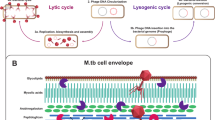Culture of mouse macrophages (RAW 264.7 ATCC strain) in wells of a 6-well plate was infected with M. tuberculosis in proportion of 15 mycobacteria per one macrophage and then treated with a lytic strain of mycobacteriophage D29. Antibacterial efficacy of mycobacteriophages was studied using D29 phage (activity 108 plaque-forming units/ml) previously purified by ion exchange chromatography. After single and double 24-h treatment, the lysed cultures of macrophages were inoculated onto Middlebrook 7H10 agar medium. The number of mycobacterial colonies in control and test wells (at least 3 wells in each group) was 300.178±12.500 and 36.0±5.4, respectively (p<0.01).
Similar content being viewed by others
References
Adriaenssens EM, Lehman SM, Vandersteegen K, Vandenheuvel D, Philippe DL, Cornelissen A, Clokie MR, García AJ, De Proft M, Maes M, Lavigne R.CIM(®) monolithic anion-exchange chromatography as a useful alternative to CsCl gradient purification of bacteriophage particles. Virology. 2012;434(2):265-270.
Eltringham IJ, Wilson SM, Drobniewski FA. Evaluation of a bacteriophage-based assay (phage amplified biologically assay) as a rapid screen for resistance to isoniazid, ethambutol, streptomycin, pyrazinamide, and ciprofloxacin among clinical isolates of Mycobacterium tuberculosis. J. Clin. Microbiol. 1999;37(11):3528-3532.
Ford ME, Sarkis GJ, Belanger AE, Hendrix RW, Hatfull GF. Genome structure of mycobacteriophage D29: implications for phage evolution. J. Mol. Biol. 1998;279(1):143-164.
Gan Y, Yao Y, Guo S. The dormant cells of Mycobacterium tuberculosis may be resuscitated by targeting-expression system of recombinant mycobacteriophage-Rpf: implication of shorter course of TB chemotherapy in the future. Med. Hypotheses. 2015;84(5):477-480.
Hatfull GF. Molecular genetics of mycobacteriophages. Microbiol. Spectr. 2014;2(2):1-36.
Kamilla S, Jain V. Mycobacteriophage D29 holin C-terminal region functionally assists in holin aggregation and bacterial cell death. FEBS J. 2016;283(1):173-190.
Liu K, Wen Z, Li N, Yang W, Wang J, Hu L, Dong X, Lu J, Li J. Impact of relative humidity and collection media on mycobacteriophage D29 aerosol. Appl. Environ. Microbiol. 2012;78(5):1466-1472.
Nieth A, Verseux C, Barnert S, Süss R, Römer W. A first step toward liposome mediated intracellular bacteriophage therapy. Expert Opin. Drug Deliv. 2015;12(9):1411-1424.
O’Flaherty S, Ross RP, Coffey A. Bacteriophage and their lysins for elimination of infectious bacteria. FEMS Microbiol. Rev. 2009;33(4):801-819.
Payne KM, Hatfull GF. Mycobacteriophage endolysins: diverse and modular enzymes withmultiple catalytic activities. PLoS One. 2012;7(3):e34052. doi: https://doi.org/10.1371/journal.pone.0034052.
Peng L, Chen BW, Luo YA, Wang GZ. Effect of mycobacteriophage to intracellular mycobacteria in vitro. Chin. Med. J. (Engl.) 2006;119(8):692-695.
Pholwat S, Ehdaie B, Foongladda S, Kelly K, Houpt E. Real-time PCR using mycobacteriophage DNA for rapid phenotypic drug susceptibility results for Mycobacterium tuberculosis. J. Clin. Microbiol. 2012;50(3):754-761.
Rybniker J, Kramme S, Small PL. Host range of 14 mycobacteriophages in Mycobacterium ulcerans and seven other mycobacteria including Mycobacterium tuberculosis — application for identification and susceptibility testing. J. Med. Microbiol. 2006;55(Pt 1):37-42.
Xiong X, Zhang HM, Wu TT, Xu L, Gan YL, Jiang LS, Zhang L, Guo SL. Titer dynamic analysis of D29 within MTB-infected macrophages and effect on immune function of macrophages. Exp. Lung Res. 2014;40(2):86-98.
Yosef I, Kiro R, Molshanski-Mor S, Edgar R, Qimron U. Different approaches for using bacteriophages against antibiotic resistant bacteria. Bacteriophage. 2014;4(1):e28491.
Author information
Authors and Affiliations
Corresponding author
Additional information
Translated from Byulleten’ Eksperimental’noi Biologii i Meditsiny, Vol. 164, No. 9, pp. 326-329, September, 2017
Rights and permissions
About this article
Cite this article
Lapenkova, M.B., Smirnova, N.S., Rutkevich, P.N. et al. Evaluation of the Efficiency of Lytic Mycobacteriophage D29 on the Model of M. tuberculosis-Infected Macrophage RAW 264 Cell Line. Bull Exp Biol Med 164, 344–346 (2018). https://doi.org/10.1007/s10517-018-3986-0
Received:
Published:
Issue Date:
DOI: https://doi.org/10.1007/s10517-018-3986-0




